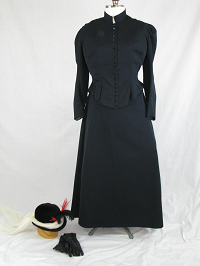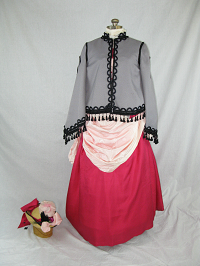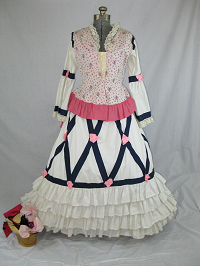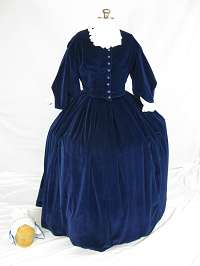
- Details
- Category: 19th century
- Hits: 2496
With the invention of the electric light, the sewing machine, and mass production, there was a general rise in the status of the middle class. The positions of women became more important. In the early 1870s, the National Women’s Suffrage Association was born. Women looked to careers other than marriage, and that brought about changes in costume. Sports became more important in American life. In addition to croquet and archery, tennis became one of the favorite games for both men and women. As women's interest in sports and athletic activity increased, so did their need for appropriate clothing to wear while engaging in these activities. Much early active wear involved some form of pants under a skirt, or pants disguised as a skirt (How the skort when from rebellious garment to athleisure staple.)
The bustle of this tennis dress has been deflated, but the new silhouette did little to give more freedom of movement to the player. The dress is swathed around the knee and wrapped in folds resembling the swaddling bands of a medieval infant, causing the wearer to walk with very small steps. There was no sign of the feet, and women appeared to move as if propelled by some invisible machinery.
The bodice of this knitted wool tunic dress fits the figure very closely by means of seams and darts that extend down to well below the hips. It presents the entire torso from shoulder to knee defined as clearly as if in a body stocking. The neckline is high, while the sleeve is long; both are trimmed in lace. The tunic is closed with a long row of hooks and eyes.
This reproduction was made by Helen Terza based on an image in Blum 1974: 128 (d).
Click photo for detailed views.
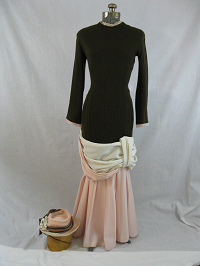
- Details
- Category: 19th century
- Hits: 2582
1870s
The 1870s saw the invention of the telephone, phonograph and light bulb. The cost of living was on the rise, but large familes were on the decline. Prudishness reached a high point. A woman would not complain about anything occurring between her neck and knees. Corseting was greatly in vogue. A small waist was much admired; a girl of 16 was expected to have a 22-inch waist, but a girl of 18 was expected to have a 16-inch waist. Women often slept in their corsets to maintain their shape. The corset cover replaced the chemise and soon evolved into the camisole. Stockings were black striped and shoes laced up the inside. Victorian women disguised chairs, tables, even smelling salts bottles, and this carried through to women's fashion with renewed interest in the bustle. The bustles were constructed of wire, horsehair and fabric and were worn to support the dress in the back. The bustle was covered with a shaped petticoat of fine linen with ruffles around the neck and wrists.
A well-dressed woman wore two skirts. For this outfit, the first is of hot pink shantung; another of pale pink is looped up and tied behind her waist. This looping adds to the effect of the bustle. The basque bodice is trimmed with the contrasting color and buttons diagonally up the front, allowing the ruffles from the false blouse to show.
A fashionable lady would never go out without her bonnet. This straw hat trimmed in flowers and ribbon fastened under her chin.
Click photo for detailed views.
- Details
- Category: 19th century
- Hits: 2758
1873
This pretty gown is copied from the June 1873 issue of Harper's Bazaar and was designed for visiting friends and relatives in the country, for out-of-door fetes, lawn parties, summer festivals, and for wearing while taking the waters at the popular mineral spring resorts. Sunbathing did not become popular until the 1920s, so ladies protected their skin by carring parasols. Blue and white crocheted gloves were also worn. The outfit was topped by a pink straw hat trimmed with navy velvet, daisies, apple blossoms, and pink and blue ribbons. The polonaise with vest front is of a printed muslin, lined with pink and trimmed with a pink ruffle. It has hook and eye closures and is boned; additional shaping is provided by front darts and side seams. The off-white muslin sleeves are trimmed with navy ribbons and pink rosettes and edged with lace. The skirt is also of off-white muslin, trimmed on the upper part with navy ribbons and pink rosettes and on the bottom with rows of flounces.
The petticoat is cut exactly like the skirt but without the flounces. It is worn over the bustle and serves to soften the look of the bustle. The bustle is made of steel bands attached to a waistband with laces which allow some adjustment to the size of the bustle. The flexible bustle was an asset in crowded assemblies, railroad cars, and carriages.
Doctors were extremely fond of critcizing corseting; their letters frequently appeared in periodicals such as Godey's. They could not understand why women continued to compress their bodies so extremely when they knew it was injurious to their health. If, by accident, a lady fell ill in a crowd, the common cry was "Cut her lace!" She often recovered quickly, but by the next day, she once again tightened the laces as demanded by "demon fashion."
Click photo for detailed views.
Page 2 of 13
